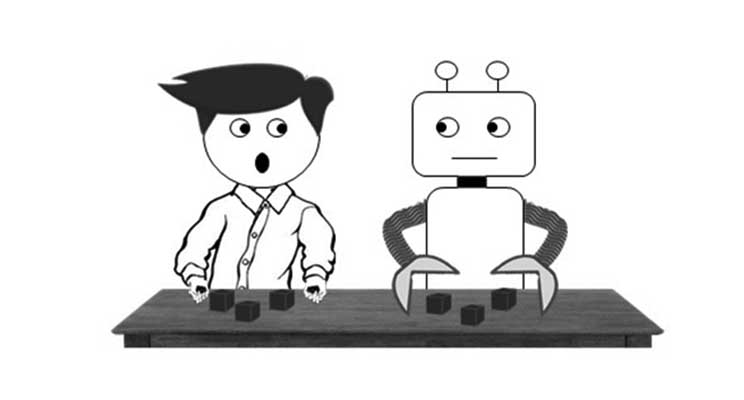Wendy’s Blog

Welcome to my blog.
Here I write about current topics in robotics that are intended to help shape and guide our transition from a world with limited robots to a world where robots are fully integrated as a part of our everyday lives. As I express my thoughts and ideas, I invite you the reader to take an active role by participating via comments or suggestions. Robots are coming… so lets take this opportunity to make the most of our unique position as those who laid the foundation for this evolutionary new era in human history. — Wendy Roberts, CEO Five Elements Robotics

Robots: A Vital Step on Our Human Evolutionary Path.
Part One: Are Robots Taking our Jobs?
October 17, 2016
People often express fear of robots taking human jobs in the workplace. The basic concern of this fear is that society will never evolve past what it is today, so of course we would imagine that many jobs held today by humans would be taken over by robots that are capable of performing the job cheaper, faster, more efficient, and with no need for rest. This fear assumes that the only recourse for people, who previously had the great fortune of holding those jobs, saw that great fortune walking out the door while they are left jobless with no other opportunities for employment. In other words, this fear assumes no evolutionary path for humans or for the society which employs them.
What do I mean by evolutionary path? Simply that we as a species have been historically evolving technologically and intellectually. We are smarter today in many respects than our ancestors were one hundred years ago. And it is both expected and desired for our children and their children’s children to be more intelligent than us. If this is not the case, then do we assume that human evolution has peaked within our lifetime?
Considering that human evolution hasn’t stopped since before civilization first emerged on this planet, it is safe to assume that it will continue. But how?
As technology continues to evolve and robots enter the scene – not only in the factories, but in our everyday lives as house keepers, security guards, personal assistants, shopping assistants and companions, we see the role that robots are playing is actually vital to our own evolutionary path. That is, they are doing the tasks and performing the jobs that are actually detrimental to us moving forward.
Imagine a worker (we’ll call him Charlie) goes to his job at the manufacturing plant and his task is to put one piece of plastic into another piece of plastic. He does this every day for five days a week, eight hours a day. He does this for years until the factory makes a new version of the product, and now he is putting a different piece of plastic into yet another different piece of plastic. How do we think that this worker’s brain evolves? How does he get smarter? Will his offspring be smarter? Unless Charlie has a very mind challenging hobby when he goes home, like learning Mandarin or nuclear physics, his mind will naturally become weaker as time progresses. If Charlie is like the majority of Americans, he probably goes home and turns on the TV for a few hours of mindless, brain numbing passive entertainment, until he must go to bed and repeat it all again. In this scenario, Charlie will not evolve intellectually and neither will his genetic makeup be encouraged to create more intellectual children.
The brain, as we know from many studies, is similar in some aspects to the rest of our muscles. In order for it to get stronger, it needs to be exercised. Mental activities which challenge our brain have several beneficial effects. They keep the neural pathways responsible for our grasp of intellectual reasoning active and open. When not used, the pathways will eventually disconnect and the ability to perform that mental activity will diminish and ultimately disappear. It is interesting to note that when we are accomplished at a particular skill that we have spent a lifetime improving upon, it is more likely than not that our children are innately adept at the same skill.
This brings us back to our factory worker, Charlie. Let’s say a robotics company designs a robot to do Charlie’s repetitive job. Now what would become of Charlie as he discovers he has been replaced by this new highly acclaimed robot that is now getting more praise in the first five minutes on the job than Charlie ever received after twenty years of dedicated service?
The interesting and often overlooked attribute of robots is that they open up a whole new field of job opportunities for us humans on our evolutionary path. In other words, robots come with a tail that presents new occupations in society. Charlie may find he now has several jobs that he can apply for. He may not be qualified for the role of robotics engineer or software designer; but testing, quality assurance, and even assembly jobs are required to support the robots that are being introduced into the factories and society. You may say, “Assembly? Aren’t we back to part A in part B?” And to that I would say, “No – robots can do that kind of repetitive assembly.” It has been my experience that assembling robots and their sub-components is challenging, requires the use of our brains, but can be learned by most people. Even those who struggle in school are able to assemble robots when given the proper training. No special degree is required and yet, all of the robot assemblers we have employed are very excited and happy to be doing their job.
So are robots here to take our jobs? Will they change our way of life and society as we know it? The answer is “Yes”! The question for us to ponder is how to use this unique opportunity in human history to launch ourselves further on our evolutionary path.
Robots: A Vital Step on Our Human Evolutionary Path.
Part Two:The Impact of Personal Service Robots on Society.
January 4, 2017
The year is 2017 and personal service robots are entering the scene. Ready or not, here they come.
It is interesting the comments I have heard about robots since I began this robotic company 4 years ago. At that time we were beginning our development of Budgee, the friendly robot that carries your things. I often heard people say that Budgee will spoil people and make them lazy. “Why can’t people carry their own stuff?” I find it interesting that people often forget that there are those who can be helped by robots. For example: many people, particularly as they age, cannot carry a lot of weight. This occurs for many reasons, but mainly due to the fact that the physical body naturally loses its strength over time. Many elderly people must leave the workforce and/or abandon independent living because they are unable to lift or carry items that are necessary for them to be a part of the workforce or to live alone. And yet, their minds may still be functioning well at the time of their departure from either the workforce or independent living. Certainly this class of people can benefit from a robot that assists them by carrying their things.
There are two key benefits of robots assisting the elderly. 1. They allow the elderly to stay in the workforce longer and 2. They allow the elderly to maintain independent living longer. These two benefits not only benefit the elderly but benefit society as well on many levels.
1. Robots That Assist the Elderly to Stay in the Workforce Longer. Why do we want the elderly to stay in the workforce longer? This change would benefit society on many levels. (a) They would be less of a drain on welfare or other government programs designed to assist them. They can postpone entry into those programs and reduce the costs of caring for them in their senior years. (b) By continuing to use their brain in a place of employment, they are able to prolong their healthy mental functioning. (My personal survey of people I know has convinced me that people who retire and do not perform mentally challenging activities have weakened brain functioning, and dementia is very common. Those who stay in the workforce well into their later years (80s+) do not see this rapid decline in mental health nearly as often.)
2. Robots That Help the Elderly Maintain Independent Living Longer. This benefits the seniors in that they can continue to live in their own homes comfortably, and longer. Certainly if given the choice, most seniors would want to live in their own homes rather than in a nursing home or with their children – not to mention the huge cost savings associated with delaying entry into a nursing home.
Another category for personal service robots is assistance for the disabled, who historically have been the forgotten segment of our American population when new technologies come to the forefront. Here is a group of people starving for independent living, and willing to put up with any new invention to get it. When Budgee first came to the market it was buggy. Certainly our customers encountered many difficulties as they took Budgee to new places and used it for purposes that we as its developer never imagined. As we worked with our early customers to make fixes, send out replacements and create software enhancements to support them in their quest to make the robot work almost anywhere (it seemed), what surprised and impressed me was the willingness of these early disabled adopters to not give up on this product. Even when we knew there were certain annoying behaviors that we could not fix at that time, these customers were issuing glowing feedback and letters of gratitude for developing a product that helped them in their quest for independent living.
As an aside, having now worked with several disabled people in connection with our Budgee product, what I realize now is that it is not just independent living that the disabled community craves, but also, and importantly for our discussion here, they want to be contributing members of society. They don’t want to be a burden – they want to be productive, contributing, helping others and most importantly they want to have a sense of self-worth. So certainly personal assistant robots will play a very vital role to helping in the evolution of this segment of society. If they are actively working with the aid of an assistant robot they can get stronger, mentally and spiritually. I suspect that it is no coincidence that the rate of depression among disabled people is astoundingly high compared to non-disabled people in general. I believe that finding ways through robotics to help them integrate into society as contributing and independent members will greatly reduce the occurrence of depression among the disabled population.
So, although there are many people who are put off by the emergence of robots in our society, there is a growing fan club and great need for robots in the disabled and elderly populations.
About Wendy:
Wendy Roberts has been cited as one of the Top Five People Paving the Path for Robotics in Mashable’s Article, “Five Individuals Pioneering the Robotics Industry”, January 2016. Also Ms. Roberts has been featured in a number of press releases and TV programs including:
• NJ Biz Magazine, “Just Like the Jetsons, Five Elements Robotics Bringing Human Robot Relationship to Everyday Life”, June, 2015
• New Jersey Technology Council, “Q&A With Wendy Roberts”, September 2015
• Digital Trends, “My Budgee and Me”, March 2015
• Wired Magazine, “The Next Big Trend, Robots that Follow You Around”, October 2014
• Fox News, Fox Business Network, aired January 2014, and 2015
• New Jersey Monthly Magazine, “Help On Wheels, Jersey Made Robots”, August 2015
• American Makers, aired Fall 2014 and 2015.
• Robohub, “25 Women in Robotics You need to Know About”, October 2015.
